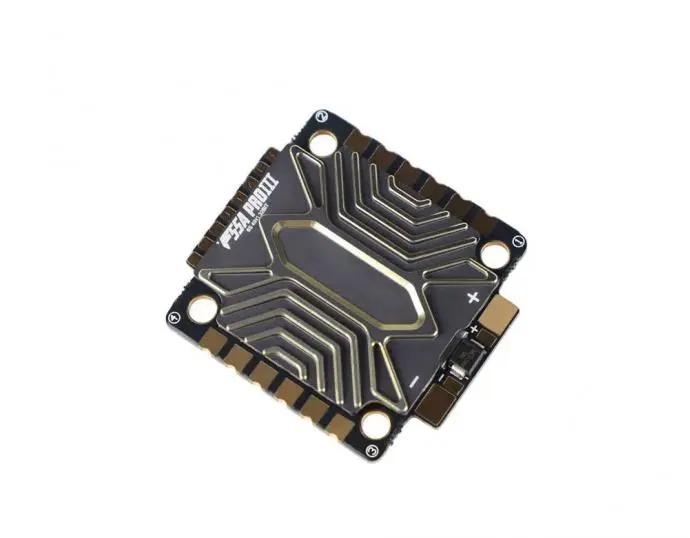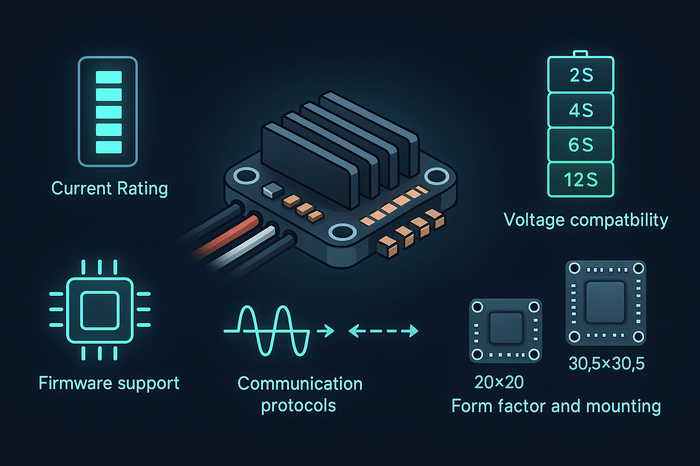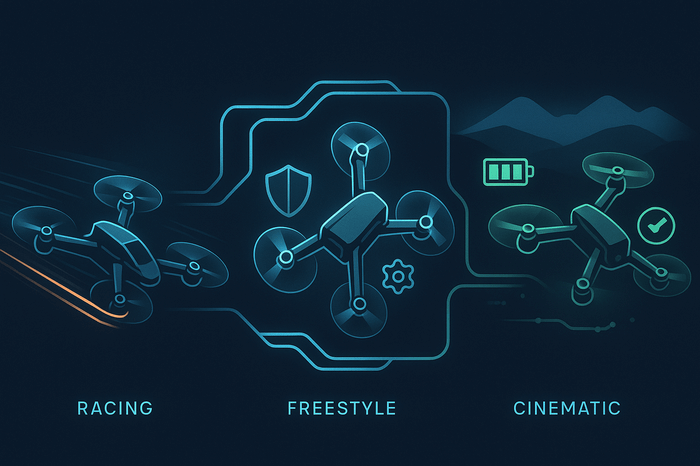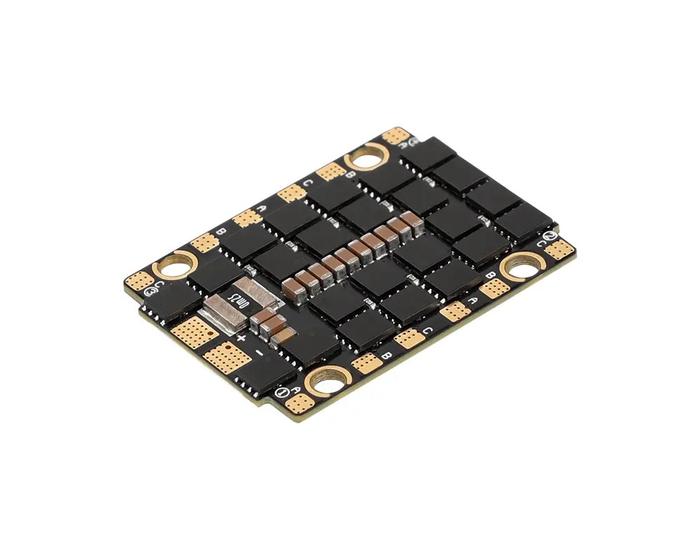How to Choose FPV ESC?

An Electronic Speed Controller (ESC) acts as the critical bridge between your flight controller and motors, converting battery power into precise motor control signals. Selecting the right ESC directly impacts your drone's performance, reliability, and flight characteristics, making it one of the most important component decisions in your build.
ESC Basics
How ESCs Function in FPV Systems
ESCs receive throttle commands from your flight controller and translate them into three-phase power signals that drive brushless motors. They regulate motor speed, direction, and timing while providing protection features like thermal and overcurrent protection. Low voltage protection is typically handled by the flight controller rather than ESC in multirotor applications.
Key ESC Functions
- Power conversion: Transform DC battery power into AC motor signals
- Speed regulation: Control motor RPM based on flight controller commands
- Safety monitoring: Protect against overcurrent and overheating
- Telemetry feedback: Send motor data back to flight controller and radio system
Core Selection Criteria

Current Rating
Your ESC's current rating must exceed your motor's maximum draw with adequate headroom for safety and performance.
- Continuous current: Sustained amperage the ESC can handle indefinitely
- Burst current: Maximum short-term current capacity (duration varies by manufacturer, typically under 10 seconds)
- Selection rule: Choose ESC rated 20-30% above your motor's peak current draw for safety margin
Voltage Compatibility
ESCs must match your battery configuration and support your desired voltage range.
- 2S-3S: Micro and tiny builds (7.4-12.6V)
- 4S-6S: Most racing and freestyle quads (14.8-25.2V)
- 8S-12S: Heavy-lift and specialized applications (29.6-50.4V)
Firmware Support
Modern ESCs use specialized firmware that affects performance and compatibility.
- BLHeli_S: Reliable, proven 8-bit firmware for most applications, supports RPM filtering with bidirectional DShot
- BLHeli_32: Advanced 32-bit firmware with ESC telemetry and variable PWM frequency, but development stopped in 2024
- AM32: Open-source 32-bit firmware, actively developed and recommended by Betaflight, supports Extended DShot Telemetry (EDT)
Communication Protocols
The protocol determines how your flight controller communicates with the ESC.
- DShot (150/300/600): Digital protocol with error checking and no calibration required - current standard
- Oneshot125/42: Legacy analog protocols for compatibility
- Multishot: Fast analog protocol, largely superseded by DShot
- PWM: Basic analog protocol for simple setups
Choose DShot speed based on PID loop frequency: 2K→DShot150, 4K→DShot300, 8K→DShot600.
Form Factor and Mounting
ESC size must fit your frame while providing adequate cooling and durability.
- 20×20mm: Compact builds, racing frames
- 30.5×30mm: Standard size for most applications
- 25.5×25.5mm: Tiny whoop and micro builds
- AIO (All-in-One FC): Flight controller integrated with 4-in-1 ESC on single board, common in micro builds
Special Features to Consider
Telemetry Capabilities
Modern ESCs can send real-time data back to your flight controller and transmitter, though capabilities depend on firmware and hardware features.
- RPM feedback: Available through bidirectional DShot on most ESCs
- Current sensing: Requires ESCs with current sensors (not all models include this)
- Temperature monitoring: Available on ESCs with temperature sensors
- Voltage reporting: Possible through Extended DShot Telemetry (EDT) or dedicated telemetry pins
Advanced Technologies
- Damped light: Regenerative braking for faster motor deceleration and improved throttle response (standard in BLHeli)
- Extended DShot Telemetry (EDT): Enhanced telemetry data transmission without dedicated telemetry wires
- CAN bus communication: Digital communication primarily used in ArduPilot/PX4 ecosystems for industrial applications
- Conformal coating: Protection against moisture and debris
Integration Options
- 4-in-1 ESCs: Single board controlling all motors, cleaner wiring
- Individual ESCs: Separate controller per motor, easier replacement
- Stack mounting: ESC/FC integration with standardized connectors
Use-Case Specific Requirements

Racing Applications
Racing demands maximum responsiveness and minimal weight penalties.
- Use appropriate DShot speeds matched to PID loop frequency (typically DShot300 for 4K loops, DShot600 for 8K loops)
- Choose lightweight form factors
- Ensure high burst current capacity for aggressive throttle inputs
- Enable damped light for faster motor deceleration and improved responsiveness
Freestyle Flying
Freestyle requires balanced performance with enhanced durability for crashes and recovery.
- Select robust construction with impact resistance
- Ensure adequate cooling for sustained high-power maneuvers
- Consider telemetry features for performance monitoring
- Balance weight vs. protection based on flying style
Cinematic and Long-Range
Smooth footage and extended flight times demand efficiency and reliability.
- Focus on efficiency ratings and low heat generation
- Choose ESCs with smooth throttle curves and filtering
- Prioritize telemetry for battery monitoring
- Select proven firmware with stable performance
ESC Selection Comparison
Common Selection Mistakes
Underrating Current Capacity
Many builders choose ESCs based on motor specifications without considering real-world conditions.
- Account for prop loading and aggressive throttle inputs
- Factor in altitude, temperature, and battery voltage sag
- Always add 20-30% headroom above calculated requirements
Ignoring Thermal Management
ESCs generate significant heat that must be properly managed for reliability.
- Ensure adequate airflow in your frame design
- Consider heat sinks or thermal pads for high-current applications
- Avoid enclosing ESCs in tight spaces without ventilation
Protocol Mismatches
Incompatible communication protocols can cause poor performance or complete failure.
- Verify your flight controller supports your chosen ESC protocol
- Ensure all ESCs support the unified DShot speed set in your flight controller
- Test communication reliability before final installation
Form Factor Incompatibility
ESC mounting and connector compatibility affects build quality and maintenance.
- Verify mounting hole spacing matches your frame
- Check connector types and wire gauge compatibility
- Plan wire routing and access for future maintenance
Quick ESC Selection Checklist
- Calculate motor requirements: Determine maximum current draw from motor specs and prop selection
- Add safety margin: Choose ESC rated 20-30% above calculated current needs
- Verify compatibility: Ensure voltage range, protocols, and firmware match your system
- Select appropriate form factor: Match ESC size and mounting to your frame design
- Consider use-case features: Prioritize telemetry, efficiency, or response based on flying style
Maintenance and Safety
Installation Best Practices
Proper ESC installation ensures reliable operation and easy maintenance.
- Use appropriate wire gauge for current capacity
- Secure all connections with quality solder joints
- Apply heat shrink or protective covering to exposed connections
- Install low ESR filtering capacitors on ESC power inputs to reduce voltage spikes and video noise
- Plan wire routing to avoid prop strikes and frame interference
Ongoing Maintenance
Regular ESC maintenance prevents failures and extends component life.
- Inspect solder joints and connections after crashes
- Monitor ESC temperatures during operation
- Update firmware when improvements become available
- Replace ESCs showing signs of heat damage or erratic behavior
Safety Considerations
ESCs handle high currents and can pose safety risks if mishandled.
- Never exceed ESC current ratings during operation
- Allow adequate cooling time between flights
- Inspect for damage before each flight session
- Use appropriate battery protection and charging practices
Popular & Recommended FPV ESCs

Our curated selection showcases the most popular and proven FPV ESCs across different performance categories and budgets. These models represent the best balance of reliability, features, and value for various FPV applications.
These ESCs span from entry-level options like the VELOX Lite V45A for budget builds to professional-grade solutions such as the CINE series for heavy-lift applications. The table progresses from lower current ratings suitable for smaller builds to high-current options for demanding applications. Key differentiators include voltage range (3-6S for standard builds, up to 12S for heavy-lift), form factor (20×20mm for compact racing frames, 30×30mm for standard builds), and firmware choice (AM32 for modern features, BLHeli32 for proven reliability). When selecting, ensure your ESC's continuous current rating exceeds your motor requirements by 20-30%, and choose mounting patterns that match your frame specifications for optimal integration.
FPV ESC Frequently Asked Questions
What is the difference between 4-in-1 and individual ESCs?
4-in-1 ESCs integrate control for all four motors on a single board, reducing weight and simplifying wiring with shorter signal paths that can reduce noise pickup. However, 4-in-1 ESCs are also strong EMI sources due to high-frequency switching, requiring proper spacing and shielding from flight controllers. Individual ESCs offer easier replacement if one fails and can provide better performance isolation, but add complexity to builds. Most modern FPV pilots prefer 4-in-1 designs for their convenience and reliability.
How do I choose the right current rating for my ESC?
Calculate your motor's maximum current draw at full throttle, then apply the common rule of thumb of selecting an ESC rated 20-30% above peak requirements. For example, if your motors draw 35A maximum, choose a 45A+ ESC. This safety margin prevents overheating and ensures reliable operation during aggressive flying. Higher current ratings generally don't harm performance (just add weight and size). Also verify your battery's C-rating can support the total current draw, as battery limitations often become the constraining factor before ESC limits.
What firmware should I use: AM32 or BLHeli32?
For new builds, AM32 is recommended as it's actively developed, open-source, and officially recommended by Betaflight for 32-bit ESCs. BLHeli32 remains usable for existing setups but development stopped in 2024, meaning no new firmware updates are available. Both support modern DShot protocols and telemetry, but AM32 offers better long-term support and new features like Extended DShot Telemetry (EDT).
Why is my ESC overheating during flights?
ESC overheating typically results from undersized current rating, poor airflow, aggressive flying with insufficient cooling breaks, or damaged components. Ensure your ESC's continuous rating exceeds motor demands, provide adequate ventilation, and consider models with enhanced heat dissipation like our F66A Mini with double-sided heatsinks.
Can I mix different ESC brands or models on one drone?
While technically possible, mixing ESCs can lead to performance inconsistencies, different response characteristics, and tuning difficulties. For optimal performance and predictable behavior, use identical ESCs across all motors. This ensures uniform timing, consistent power delivery, and simplified PID tuning.
What mounting pattern should I choose for my build?
20x20mm mounting works well for 3-4 inch racing builds and weight-critical applications. 30x30mm (30.5x30.5mm) suits most 5-7 inch builds and provides better component spacing. Choose based on your frame's stack design and available space - most modern frames support both patterns.
How important is telemetry support in FPV ESCs?
Telemetry can provide real-time data through your OSD, but available information depends on ESC firmware and wiring setup. UART telemetry or bidirectional DShot/EDT protocols can transmit voltage, temperature, and RPM data. However, 4-in-1 ESCs typically only have one current sensor for total current, not per-motor readings. Battery voltage monitoring is usually handled by the flight controller's VBAT sensor rather than ESC telemetry. While not essential for basic flying, telemetry can enhance safety and help with performance tuning when properly configured.
Recommended Reading: FPV ESC Guides & Categories
Expand your FPV knowledge with these comprehensive resources covering essential components and expert insights for building high-performance drones.
Related FPV Components
Building a complete FPV system requires careful selection of compatible components. Explore these essential categories to optimize your drone's performance:
FPV Drone Parts - Complete collection of FPV components including frames, cameras, VTX systems, and accessories for racing and freestyle builds.
FPV Drone Motors - High-performance brushless motors designed specifically for FPV applications, from lightweight racing motors to heavy-lift cinematography solutions.
FPV Propellers - Precision-engineered propellers optimized for different flying styles, including racing, freestyle, and long-range configurations.
FPV Flight Controllers - Advanced flight control systems with cutting-edge processors, gyroscopes, and firmware support for demanding FPV applications.
Expert Guides & Technical Resources
Deepen your understanding with professional insights and detailed technical guides from industry experts:
Best FPV Freestyle Drone Motors 2025 - Comprehensive analysis of top-performing motors for freestyle flying, including power characteristics, durability testing, and compatibility recommendations.
The Ultimate FPV Drone Motor Guide - In-depth technical guide covering motor specifications, selection criteria, and performance optimization for various FPV applications.
These resources provide valuable insights into component selection, system integration, and performance optimization to help you build the perfect FPV setup for your flying style and requirements.




